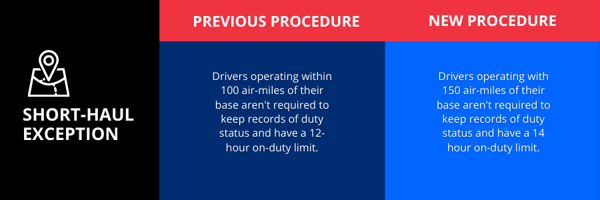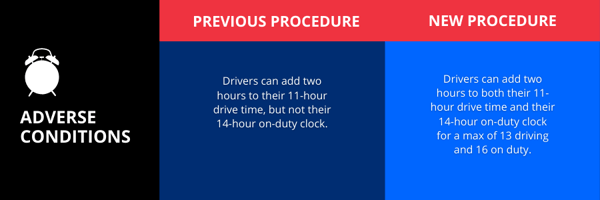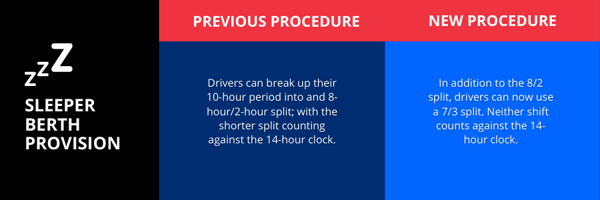New Hours of Service (HOS) Changes: What You Need to Know
Written By: Kellie Lynch
2020 HOS changes: FAQs & impact on truck drivers explained
On September 29, 2020, new revisions to the FMCSA's Hours of Service (HOS) rule will enter into effect. The new rule gives drivers greater flexibility and includes changes to 4 Key provisions:
- Short-Haul Exception
- Adverse Driving Conditions Exception
- 30-Minute Break Requirement
- Sleeper Berth Provision
We'll discuss how the FMCSA arrived at these changes and answer any questions you might have about the new rule. If you still have questions after viewing this guide, contact your terminal manager or regional safety manager. You can also email safety@containerport.com or contact us.
How did the new Hours of Service (HOS) come about?
The FMCSA received input from truckers, motor carriers (MCs), safety advocates, Congress and other stakeholders to develop the new HOS rule. The goal was to give truckers greater flexibility in how they schedule their day to be most productive while still maintaining safety standards on America's roads.
The rule is estimated to result in over $270 million in regulatory cost-savings, strengthening the motor carrier industry and helping to create more jobs — something FMCSA's Joe DeLorenzo says is "especially important now as we work through economic recovery" in the wake of the COVID-19 pandemic.
The rules were determined through a 3-step process spanning 3 years.
In 2018, FMCSA received over 5,000+ comments on their "Advanced Notice of Proposed Rulemaking" which was held to determine if revisions to HOS could "alleviate unnecessary burdens placed on drivers while maintaining safety."
In 2019, they received 2,800+ comments on the "Notice of Proposed Rulemaking" which sought input on the 5 specific changes they proposed to the HOS rules.
And in 2020, the rule was finalized and is currently being implemented.
What are the changes?
Short-Haul Exception
The Short-Haul Exception (§395.1(e)(1)) states: "Property & passenger carriers using the short-haul exception are not required to use a Record of Duty Status (RODS) or Electronic Logging Device (ELD), or take a 30-minute break" within a maximum driving distance and maximum duty period.
The change modifies the maximum driving distance and duty period to:
- Old Rule - 100 air miles, 12-hour duty day
- New Rule - 150 air miles, 14-hour duty day

Why did the FMCSA change the short-haul exception rule?
This change gives you an expanded driving service area and additional time to use the exception. If you comply with the rule, you don't have to fill out a RODS. The only consequence, DeLorenzo explains, is if there are days where you can't meet the exception as a short-haul driver, you must fill out a logbook or use an ELD for those particular days.
How do I use the Short-Haul exception?
According to the FMCSA, to use this exception, you must:
- Operate within a 150 air-mile radius
- Not exceed a maximum duty period of 14 hours
- Start and end your shift in the same location (you must return to where you started that day)
- Have at least 8 (passenger) or 10 (property) hours off between shifts
- Include the start and end times for the day and the total hours on-duty on the time record. This record has to be maintained and available upon request at the carrier's place of business, but does not have to be brought along in the cab with you.
Note: The new HOS rule does not change any other provisions of the §395.1(e)(1) short-haul exception, nor does it change the non-CDL short-haul exception in §395.1(e)(2).
Keeping accurate records is a must. To operate under the short-haul exemption, the motor carrier is responsible for recording the driver's time in, time out, and total number of hours per day. This record should also include the total time for the 7 days preceding, and be maintained for at least 6 months.
What happens if I don't meet the exception requirements?
If you no longer meet the exception (got held up, the customer was located outside of the 150-mile radius, etc.), you must complete a log book or use an ELD for that day (see §395.8).
I didn't meet the short-haul exception, when do I need to use an ELD?
Per the ELD rule, drivers are exempt from using an ELD as long as the total number of days within a 30-day period that you're required to fill out the log is 8 or less. If there are more than 8 days within a 30-day period that you exceed the exception, you must use an ELD to record the time for that day.
"Keeping that in mind, in terms of scheduling and operations, where there's times you may go over that 14 hours or 150 miles and need to fill out a log book, as long as it remains at 8 or less, the driver can stick with the paper logs and not need an ELD for those days," said DeLorenzo, "so keeping that in mind in terms of how you operate and how drivers are scheduled is probably the most important piece when taking advantage of this exception."
TL;DR
Starting Sept 29, you can now use the short-haul exception if you are a CMV driver and are operating within a 150 air-mile radius, don't exceed a 14 hour maximum duty period, and comply with the rule's other tenets.
Adverse Driving Conditions Exception
The FMCSA defined Adverse driving conditions (§395.2) as "snow, sleet, fog, or other adverse weather conditions, a highway covered with snow or ice, or unusual road and traffic conditions;
- Old Rule - none of which were apparent on the basis of information known to the person dispatching the run at the time it was begun
- New Rule - that were not known, or could not reasonably be known, to:
- a driver immediately prior to beginning the duty day or immediately before beginning driving after a qualifying rest break or sleeper berth period or;
- a motor carrier immediately prior to dispatching the driver.

Why did the FMCSA change the Adverse Driving Conditions Definition?
The rule was changed to bring the driver into the picture and include your input in the determination of adverse conditions.
"So what we've done here is give the driver some leeway here in knowing what the conditions may be, so it's not just up to the dispatcher as it had been in the past," explained FMCSA's Rich Clemente.
In addition, the HOS final rule extends the duty day by 2 hours when adverse driving conditions are encountered:
- The Property carrier 14-hour on-duty window (§395.3(a)(2)) is extended to 16 hours in Adverse Driving Conditions.
- Note: You can add those two hours to both your 11-hour drive time and your 14-hour on duty clock for a maximum of 13 driving and 16 on-duty.
- The Passenger carrier 15-hour on-duty window (§395.5(a)(2)) is extended to 17 hours in Adverse Driving Conditions.
Reminder: You should always annotate details of the adverse condition in your log or ELD when utilizing the Adverse Driving Conditions Exception.
TL;DR
You now have an additional 2 hours of driving time when impacted by adverse conditions and have leeway on identifying if conditions are adverse, which was previously left up to just your dispatcher.
30-Minute Break Requirement
The FMCSA requires drivers to take a 30-minute break after driving for a total of 8 hours (driving time does not need to be consecutive). The 30 minute break can be satisfied with a 30-minute consecutive period of:
- Old Rule - Off-duty & sleeper berth time.
- New Rule - Off-duty, sleeper berth, and on-duty, not driving time.

Why did the FMCSA change the 30-Minute Break Requirement?
Previously, drivers carrying property were required to take a 30-minute break after 8 hours on-duty time (§395.3(a)(3)(ii)), which could only be satisfied by off-duty and sleeper berth periods.
"Previously, the rule was tied to the start of the day, and when an individual worked at least 8 hours including driving time, they would have to take a 30 minute break," said Clemente.
The new break, instead, is based on 8 hours of cumulative (not consecutive) driving time, and adding the on-duty, non-driving status gives drivers increased flexibility to be productive on their break while still remaining compliant.
"The break can be satisfied in any of those three ways, and the time has to be consecutive, and it could be in these different duty statuses," explains Clemente, "For example, 10 minutes of off-duty, 10 minutes of sleeper berth, and 10 minutes of on-duty, non-driving time. Again, that time (30 minutes) would all have to be spent consecutively."
TL;DR
Your 30-minute break requirement can now be satisfied by Off-duty, sleeper berth, and on-duty, non-driving time as long as it is 30 minutes consecutively.
Sleeper Berth Provision
The Sleeper Berth provision requires drivers to have an off-duty period of 10 hours.
- Old Rule - Drivers can break up their 10-hour period into and 8- hour/2-hour split; with the shorter split counting against the 14-hour clock.
- New Rule - Drivers can now split their off-duty period as follows, with neither split counting against the 14-hour clock:
- One off-duty period (whether in or out of the sleeper berth) that is at least 2 hours long and;
- A second off-duty period that is at least 7 consecutive hours in the sleeper berth
- As long as the 2 periods add up to 10 hours, neither period will count against your 14-hour driving window.
- You can still take a 10-hour consecutive break if you so choose.

Why did the FMCSA change the Sleeper Berth Provision?
After hearing feedback from drivers, the FMCSA decided to split the 10-hour off-duty period and not count either split against the driving time to give you more flexibility in when you take your breaks.
"This provides the ability for a driver to have a little bit of flexibility for when they take their time, utilize that flexibility to allow themselves to be more efficient, perhaps by taking one of those off-duty periods at a time when there's rush hour traffic, or something along those lines, and allow them to be more productive because that time isn't counting against their 14-hour day," DeLorenzo explained.
TL;DR
You can now split your Sleeper Berth time into two chunks, one at least 2 hours and one at least 7 consecutive hours, and it will not count against your 14-hour driving clock so long as both periods add up to 10 hours.
In Conclusion
After listening to testimony from drivers and other industry stakeholders, beginning Sept 29, the FMCSA is implementing changes to the HOS rules to give drivers more flexibility in how they plan their days, while still upholding safety standards. These changes effect 4 key provisions - Short-Haul Exception, Adverse Driving Conditions Exception, 30-Minute Break Requirement. and the Sleeper Berth Provision.
If you have any questions about how these changes could impact you, get in touch with your terminal manager or regional safety manager. You can also email safety@containerport.com or contact us.
Additional Resources
- Watch the HOS Rule Changes Webinar
- Additional information is available on the FMCSA website.
- Download our Cheat Sheet to the HOS rule changes
.png?width=905&name=HOS%20Changes%20(1).png)